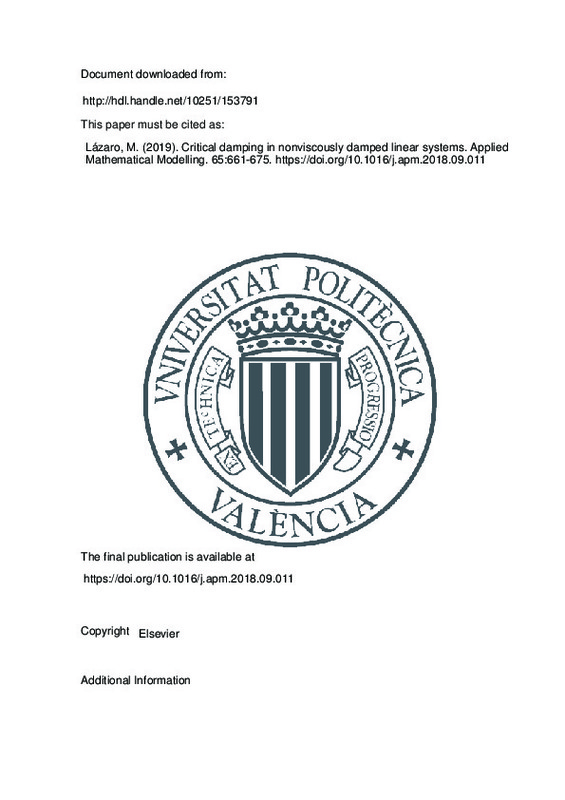JavaScript is disabled for your browser. Some features of this site may not work without it.
Buscar en RiuNet
Listar
Mi cuenta
Estadísticas
Ayuda RiuNet
Admin. UPV
Critical damping in nonviscously damped linear systems
Mostrar el registro sencillo del ítem
Ficheros en el ítem
| dc.contributor.author | Lázaro, Mario
|
es_ES |
| dc.date.accessioned | 2020-10-31T04:32:36Z | |
| dc.date.available | 2020-10-31T04:32:36Z | |
| dc.date.issued | 2019-01 | es_ES |
| dc.identifier.issn | 0307-904X | es_ES |
| dc.identifier.uri | http://hdl.handle.net/10251/153791 | |
| dc.description.abstract | [EN] In structural dynamics, energy dissipative mechanisms with nonviscous damping are characterized by their dependence on the time-history of the response velocity, mathematically represented by convolution integrals involving hereditary functions. Combination of damping parameters in the dissipative model can lead the system to be overdamped in some (or all) modes. In the domain of the damping parameters, the thresholds between induced oscillatory and non-oscillatory motion are named critical damping surfaces (or critical manifolds, since several parameters can be involved). In this paper the theoretical foundations to determine critical damping surfaces in nonviscously damped systems are established. In addition, a numerical method to obtain critical curves is developed. The approach is based on the transformation of the algebraic equations, which define implicitly the critical curves, into a system of differential equations. The derivations are validated with three numerical methods covering single and multiple degree of freedom systems. | es_ES |
| dc.description.sponsorship | The author gratefully acknowledges the support and help provided by Professor Marcelo Epstein of the University of Calgary (Canada) in the edition of this manuscript during the summer of 2017. The author also acknowledges the support of the Universitat Politecnica de Valencia with its Programa de Apoyo a la Carrera Academica del Profesorado 2017 oriented to Research Stays in other Universities and Research Centers. | es_ES |
| dc.language | Inglés | es_ES |
| dc.publisher | Elsevier | es_ES |
| dc.relation.ispartof | Applied Mathematical Modelling | es_ES |
| dc.rights | Reconocimiento - No comercial - Sin obra derivada (by-nc-nd) | es_ES |
| dc.subject | Critical damping surfaces | es_ES |
| dc.subject | Nonviscous damping | es_ES |
| dc.subject | Viscoelastic damping | es_ES |
| dc.subject | Eigenvalues | es_ES |
| dc.subject | Hereditary functions | es_ES |
| dc.subject | Overdamping | es_ES |
| dc.subject.classification | INGENIERIA AEROESPACIAL | es_ES |
| dc.title | Critical damping in nonviscously damped linear systems | es_ES |
| dc.type | Artículo | es_ES |
| dc.identifier.doi | 10.1016/j.apm.2018.09.011 | es_ES |
| dc.rights.accessRights | Abierto | es_ES |
| dc.contributor.affiliation | Universitat Politècnica de València. Departamento de Mecánica de los Medios Continuos y Teoría de Estructuras - Departament de Mecànica dels Medis Continus i Teoria d'Estructures | es_ES |
| dc.description.bibliographicCitation | Lázaro, M. (2019). Critical damping in nonviscously damped linear systems. Applied Mathematical Modelling. 65:661-675. https://doi.org/10.1016/j.apm.2018.09.011 | es_ES |
| dc.description.accrualMethod | S | es_ES |
| dc.relation.publisherversion | https://doi.org/10.1016/j.apm.2018.09.011 | es_ES |
| dc.description.upvformatpinicio | 661 | es_ES |
| dc.description.upvformatpfin | 675 | es_ES |
| dc.type.version | info:eu-repo/semantics/publishedVersion | es_ES |
| dc.description.volume | 65 | es_ES |
| dc.relation.pasarela | S\369111 | es_ES |
| dc.contributor.funder | Universitat Politècnica de València | es_ES |







![[Cerrado]](/themes/UPV/images/candado.png)

